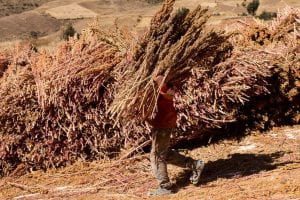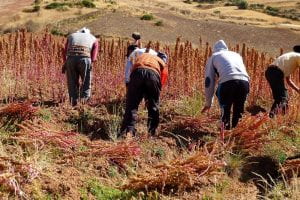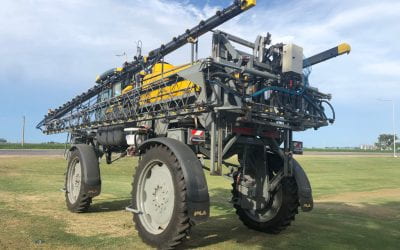Quinoa
A Super Grain, Not a Silver Bullet
Quinoa, a bit player in the global food scene two decades ago, was scarcely known outside of where it was grown in the Andes. In 2013, when I returned to Cusco, the ancient capital of the Incas, it had captured the imagination of tourists and Peruvians alike. Boutique grocery stores carried a dazzling array of quinoa snacks. The farmers market was strung with banners promoting quinoa as an Indigenous crop, and the Peruvian First Lady Nadine Heredia had been designated as Special Ambassador for the International Year of Quinoa by the United Nations.
Quechua farmers in the Andean highlands appreciated the tiny seed, better known as a grain, but had always grown it in modest amounts. I became more intrigued by the quinoa craze after I met up with Lorenzo Cusimayta (a pseudonym to protect villagers’ identities) at the annual Huancaro Agricultural Fair. A curious and knowledgeable man, he was a highly respected farmer whom I knew well. He was from Huanoquite, a district of about 5,000 inhabitants located some forty miles southwest of Cusco where I had been doing research since 1984. He was perusing various booths demonstrating different kinds of quinoa and was particularly interested in one advertising black quinoa. After much back and forth, he purchased some to try it out.
Lorenzo’s field of quinoa. Photo by Linda J. Seligmann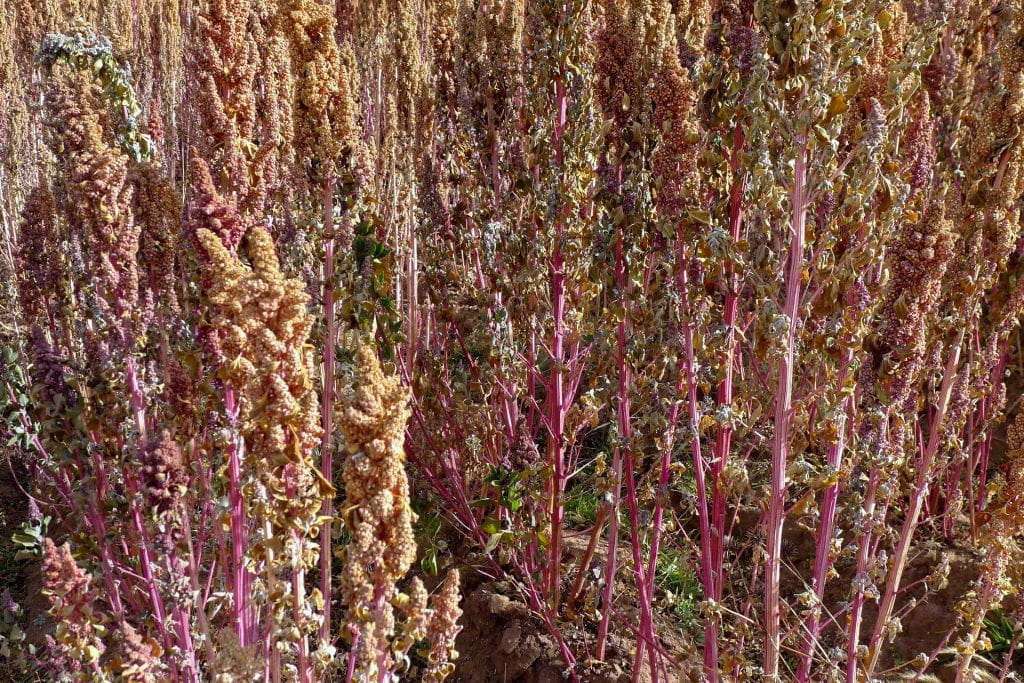
When I traveled back with him to Huanoquite, I found that a group of men and women, including Cusimayta, had established a “Quinoa Cultivators Association” (QCA). With the help of Cusco’s regional government and National Institute for Agricultural Innovation (INIA), which was promoting native Andean crops, they had started growing quinoa at a greater scale. They hoped that, eventually, their quinoa would gain formal organic certification, a process that could take up to three years. The wait could be well worth it because of the high returns they expected sales would command on the export market.
A remarkable plant, quinoa has a high percentage of protein, iron, Vitamin B6, Vitamin E, copper, zinc, phosphorus and magnesium; it contains all the amino acids that the human body needs but cannot produce itself; it is an excellent source of dietary fiber; it can be transformed into baked goods, drinks, cosmetic products and soups. According to Leah Dobkins, author of a book of quinoa recipes, paratroopers in World War II took quinoa with them as a portable superfood. More recently, NASA selected quinoa as a crop for long-duration manned spaceflights. Its by-products also turn out to be useful. A bitter outer hull called saponin encases the tiny grain and must be removed through manual or mechanical rinsing for the quinoa to be edible. It turns out that saponin can be used as a shampoo and an effective organic pesticide.
While people are familiar with quinoa’s properties as a superfood, they have paid little attention to what has been happening to the farmers encouraged to grow it as a non-traditional export commodity. I returned to Huanoquite in 2018 ready to investigate systematically the impact of the global demand for quinoa on Huanoquite’s farmers. Was it improving their livelihoods? How was it shaping their farming decisions and practices? Were they reducing their cultivation of other crops in order to focus on quinoa? How were women participating in these changes that also could affect what and how they cooked for their families?
Multiple microecological zones of Huanoquite. Photo by Linda J. Seligmann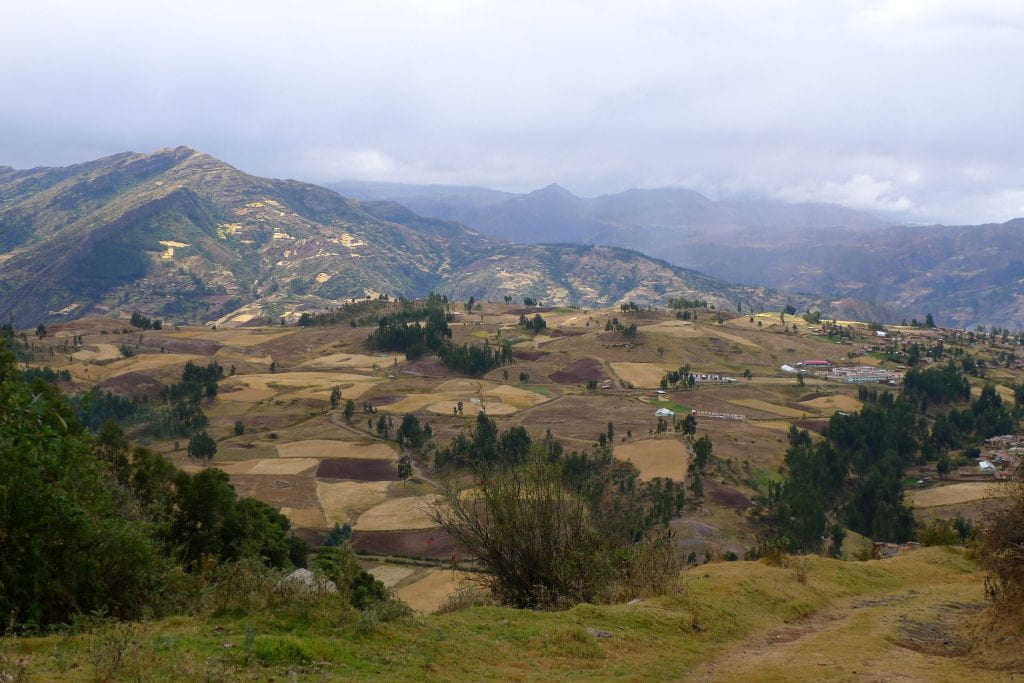
When I began my research there, Huanoquite took at least eight hours to reach by giant lorries. The road of terrifying hair pin curves which passes through a staggeringly beautiful landscape now took about an hour and a half due to road improvements and the formation of Huanoquite’s youth into a chauffers’ association. They drove their sedans and vans back and forth once a day between Cusco and the district. This connectivity dramatically changed life for people’s ready access to markets, educational institutions and employment opportunities.
Long renowned for its plentiful water and diverse ecological zones that range from lower temperate valleys to high peaks, Huanoquite’s primary inhabitants are Quechua farmers who have learned to take advantage over millennia to harness this diversity. They grow an extraordinary number of different crops, some native, some brought by the Spanish, such as wheat and barley, during their invasion in the early 16th century. And they continue to create local varieties of quinoa adapted to differing microecological conditions of rain, frost, altitude, sun and soil. Some scientists have found there are at least 3,000 varieties of quinoa, and most likely, there are many more. The looming threat of global climate change has promoted the storage of quinoa varieties in seed and germ plasm banks in Peru and Norway.
When I reached Huanoquite, Cusimayta told me we needed to go right away to his quinoa field to decide if it was time to harvest. While we sat at the edge of the field eating delicious thirst-quenching oranges Cusimayta inspected it while his teenage grandson set off bottle-rockets to scare away pesky finches attacking the quinoa. Cusimayta determined the time was right and told me to be ready the next day at 6:30 a.m. sharp.
A work party of 12 men had agreed to help with the harvesting in exchange for copious amounts of 90% proof liquor, beer, coca leaves, food and a small wage. Before beginning their labor, and during the breaks that were few and far between, the men blessed the earth and mountain beings, and in the course of their conversations, they reflected on their preoccupation with yet another development taking place: mining. While some welcomed the possibility of new jobs, others worried about the contamination of their water sources and the prospect of injuries working with heavy machinery. Several of them told of stories of finding gold in different places only to return to find it had vanished.
Labor party chewing coca and making offerings before beginning work. Photo by Linda J. Seligmann
Harvesting the quinoa was arduous. The men bent over the stalks, cutting them with scythes, stacking it to dry and eventually transporting it to a tarp where it could be run through a wheat thresher. The stalks were sharp, and in my eagerness to assist, I stupidly failed to realize I had not worn long-sleeves. Scratches that did not disappear for months covered my arms. Lorenzo admonished me for my failure to balance properly my load of stalks thereby causing some of the seeds to fall to the ground. The men worked steadily with few complaints. When they returned to thresh the quinoa two weeks later, the thresher produced enormous amounts of dust and clogged regularly. It was always a young girl who was responsible for holding the bag to capture the grain as the fine particulates billowed around her.
- 5. Carrying harvested quinoa and stacking it to dry. Photo by Linda J. Seligmann
- Labor party harvesting quinoa. Photo by Linda J. Seligmann
While the harvest was a good one, the challenge for the QCA was to find buyers for it at a decent price. When the celebration of quinoa on the world stage had first begun, the price skyrocketed and the farmers were overjoyed. The harvest the next year was excellent and the president of the association had been thrilled to locate three prospective buyers. However, before they even had a chance to make an offer, prices declined precipitously and the farmers did badly.
They became more cautious and jittery about the market and some dropped out of the QCA. The next year, they pooled their harvest to distribute risk and carefully followed the instructions of the regional government and INIA to only use organic fertilizer and non-chemical pesticides on the fields where they were growing their quinoa. A buyer from Arequipa agreed to purchase all their quinoa for export. However, before the farmers were paid the buyer claimed he had to reject it because it showed traces of pesticides and chemical fertilizer. This was a devastating blow to association members who vehemently claimed the quinoa had either been mixed with other growers’ non-organic harvests or that traces appeared in their quinoa because they had grown potatoes with pesticides and chemical fertilizer in a prior year as part of their multi-year crop rotation. The only saving grace about the debacle was that quinoa has yet another great property—it can be stored up to ten years. Many farmers stored their quinoa, used part of it for seed for the next year, and consumed part of it. Eventually, they got a price several years later for it that was acceptable.
Questions of access to credit, reliable contracts and market instability thwart the prospects of quinoa as a non-traditional export commodity. More subtle challenges also faced farmers who embarked on this experiment. Culture, politics and economics are intertwined in the power of this grain. On the one hand, quinoa, as an Indigenous crop, could serve as a boon to counter malnutrition and poverty, a great replacement for rice or noodles, for example, that could be served regularly in schools. The state or district municipality may eventually provide the economic support for this initiative but while I was there, it remained the burden of women to offer their labor and quinoa from their households without any remuneration for school breakfasts and lunches., and they simply did not always have the quinua or time to make such contributions. And NGOs and government personnel often perceived women as the cause of poor nutrition in households rather than targeting underlying structural causes of such conditions, including the long history of racism and colonialism and the devaluation of Indigenous knowledge. Members of the QCA also had to be able to take risks, something that most farmers could not do, thus contributing to increasing inequalities among farming households.
Furthermore, as we well know from our own experiences of preparing and eating meals, just because a food has positive health qualities and appeal, that does not necessarily mean we want to eat it as the centerpiece of our meals. A meal is composed and people have ideas about how its components should go together in light of its aesthetic and nutritional qualities. And these ideal qualities vary cross-culturally. Women are the main feeders of their households in Huanoquite. They love the taste of quinoa; they mainly consume it in soups; they make flour from it and mix it with milk; they occasionally boil it as a side starch, and they are open to new recipes. They prefer certain kinds of quinoa, such as yellow quinoa (amarilla) to other kinds. But the kind they prefer requires much more processing. Sometimes, to get rid of the saponin, it must be rinsed eight to ten times, whereas white quinoa requires almost no rinsing.
Harvested yellow quinoa (Photo by John R. Cooper)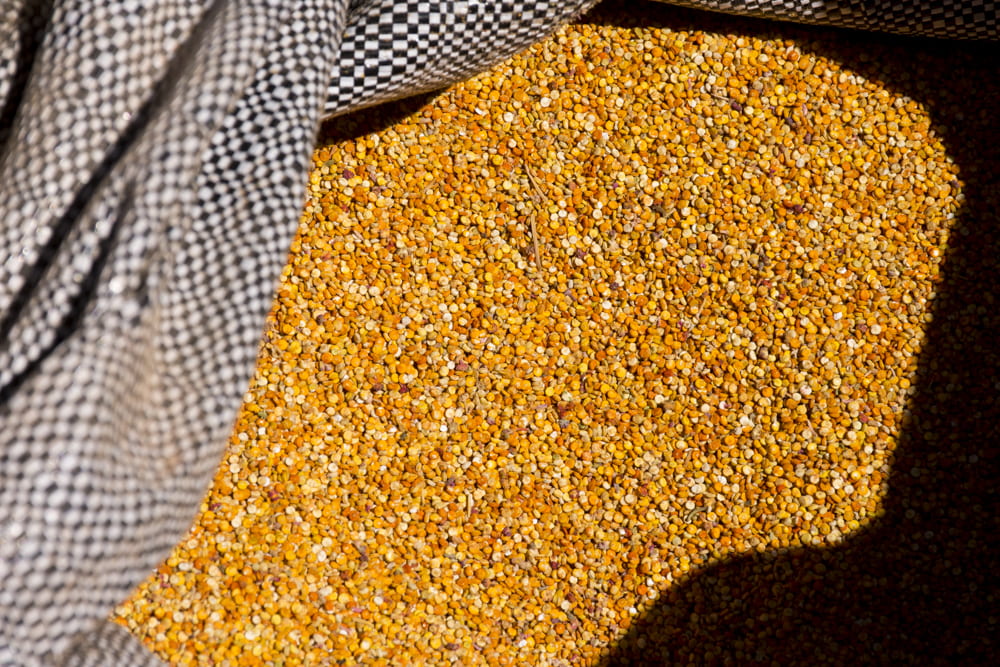
Quinoa project agents encouraged farmers to grow white quinoa even though many women told me how much they preferred other kinds. It was easier to process but because it did not have as much saponin, the birds attacked it more. And farmers were encouraged to grow only quinoa in their field rather than intercrop it, as they had once done, with corn, which they claimed had a kinship with quinoa and protected it more from birds.
This tendency toward mono-production of a crop variety was exacerbated by promises that NGO and government project personnel had made that a wondrous machine would be provided to villagers that would do the rinsing for them. The women were ecstatic about this prospect. After five years, the machine finally arrived, similar to a rice pearler. Although the QCA was told that an engineer would come to teach them how to use it, he did not arrive until the last year of the quinoa project. The outcome was especially disappointing for the women as it turned out the machine could only “pearl” the quinoa in small amounts, thus defeating its whole purpose in enhancing farmers’ ability to sell quinoa at a higher price on the market and consuming greater quantities domestically.
It is worth contemplating how other people view the consumption of quinoa. For the Peruvian nation, producing quinoa for the global market is seen as part of the celebration of Indigeneity and the Peruvian nation. It is a way to forget the horrors of a brutal armed conflict in the 1980s and early 1990s in which Quechua people were caught in the cross-fire and at least 70,000 people were killed. It is also emblematic of the huge popularity of Peruvian gastronomy that the chef Gastón Acurio has successfully promoted. In Europe, North America and Asia, quinoa is consumed to enhance individual well-being and health, often alongside other “healthy” foods, such as sushi, cranberries, and kale. In evaluating it, consumers take account of how quickly it can be prepared, its specific chemical and nutritional qualities are, how it contributes to individual well-being and whether or not it is organic.
Sushi wrapped in quinoa for sale at gourmet supermarket in the United States. Photo by Linda J. Seligmann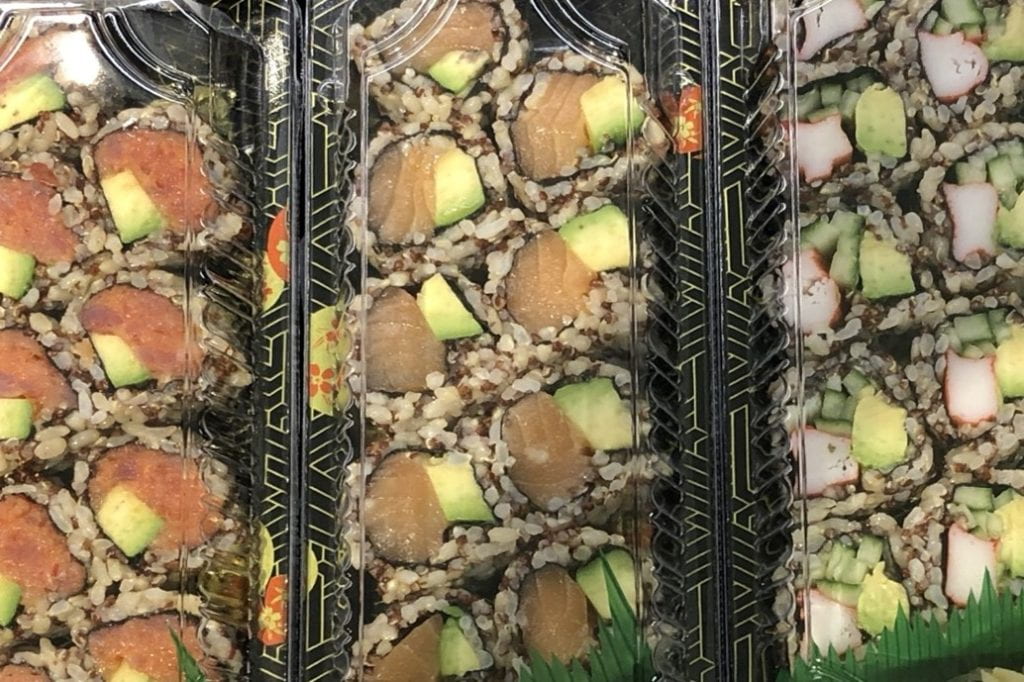
Behind these divergent understandings of quinoa as a crop to be grown, marketed and consumed lies yet another specter: the future well-being of Quechua agrarian communities. Over many centuries, they have honed their capacity for resilience, resistance, diversification and selective experimentation. Quechua Indigenous people thrive in what others might consider a harsh and unforgiving environment because of how they practice well-being: they strive to maintain equilibrium with all the sentient beings that constitute the world of which they are a part—that range from humans and animals to plant, earth, light and water beings. They also stretch their labor across diverse economic activities. Too often NGO and government projects ignore the value of this diversity, and attentiveness to the interactive dimensions of the forces of the universe, as well as the energetic demands it takes.
Currently, Quechua agrarian communities face enormous struggles in the face of mining concessions granted throughout Peru. Some of these mines have been staked out close to five sacred lakes at an ethereal altitude from which Huanoquite’s crystalline water comes from. These lakes are the site of many narratives that warn passers-by not to disturb the waters or else livestock and wild geese will drown, floods will come, and miners will die. Farmers are deeply worried about how the mines will contaminate their water supply.
Lakes of Qaranqa, Huanoquite’s principal water source and where mining concessions have been granted. Photo by Linda J. Seligmann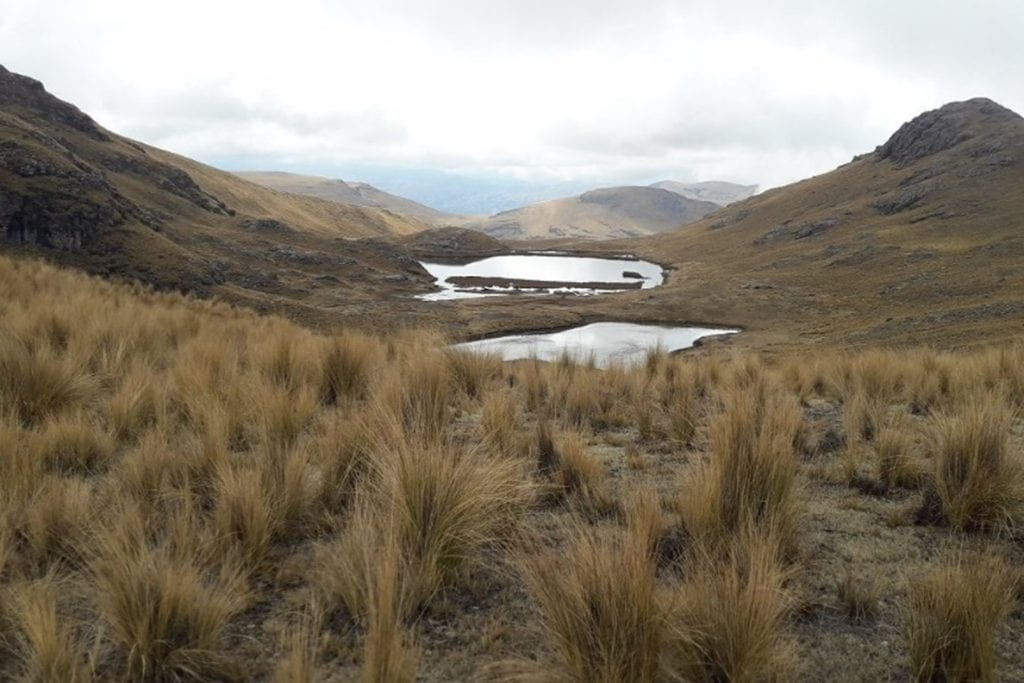
The chain from a tiny grain that becomes swaying stalks of rainbow colors and a potent superfood to a global commodity to mining operations that could jeopardize Quechua agrarian livelihoods is long, tangled and often opaque. It entails not only dreams and aspirations, but also the destructive possibilities of economic and emotional extraction by jeopardizing people’s livelihoods, catalyzing their anxiety and sapping their energy and even their sense of identity.
Scaling up quinoa production is a small part of a broader and deeper story. Its expansion would require learning from successful development initiatives that Indigenous inhabitants have designed and implemented. It also would mean rejecting quinoa as a silver bullet and instead realizing that its expansion can only take place within the context of diversification as an essential value and tool. Development initiatives are never neutral and development itself requires scrutinizing the kinds of assumptions that underlie so many ideas that people take for granted about nutrition, gender, well-being, and tasty food.
Linda J. Seligmann is a professor emerita of anthropology at George Mason University. Her publications include Quinoa: Food Politics and Agrarian Life in the Andean Highlands, Peruvian Street Lives, and The Andean World, co-edited with Kathleen Fine-Dare.
Related Articles
Editor’s Letter: Agriculture and the Rural Environment
From agribusiness to climate change to new alternative crops, agriculture faces an evolving panorama in Latin America and the Caribbean.
Local “sweetening” of the Cocoa Commodity? Alternative Economies in the Peruvian Amazon
The road was nearly impassable again because of the rain.
Agro-technological Revolutions in Latin America
When we speak about a revolution in agriculture in Latin American history, most scholars rightly think of peasant revolts, land tenure struggles or commodification of crops, to name a few of the most salient themes.

